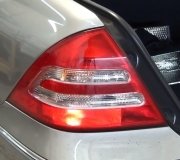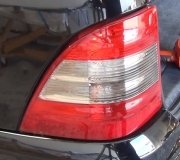This is very confusing.
"When brake is pressed, only left tail light comes on". Do you really mean the tail light or do you mean the brake light? If it is dimmer than a normal brake light, that symptom by itself suggests a bad ground wire but you should see a light on the other side of the truck is on dim too. If it really is the tail light, check that socket for being wired correctly and that the correct bulb is in it.
"Neither turn signal works. If I leave the turn signal on, the signal will work". If it flashes too slowly, that is because not enough current is flowing through the flasher to heat up the heating element to make it turn on and off. That can also be due to a bad ground wire but it will do that if the front signal isn't connected, either due to a wiring problem or a defective signal switch. Those little mechanical flashers are matched to the number of bulbs they must feed. On most trucks that is two per side so missing one bulb will make it flash real slow if at all. Be sure you don't have a flasher installed that is for a three or four-bulb system. Hazard flashers are designed to run at least four bulbs and depending on how they're wired inside may not work with a two-bulb system.
Given the multiple interrelated symptoms, I think I'd start by removing all the tail light and running light bulbs except for one rear bulb, and start with the running lights. Leaving all the other bulbs out removes any potential alternate ground path so the bulb you're working with can't turn on until you have the feed and ground wires both working, then you can move on to the next function, in this case, the brake light. Once you have them working correctly there is a good chance the signals will be working correctly too. If the tail light doesn't work, measure the voltage on the terminal inside the socket with a test light. If there's no voltage there, you have a wiring problem. If you DO find voltage there, first inspect that terminal to see if it has melted the plastic and has sunk into it. That will prevent it from making contact with the bulb's terminal. If you do have voltage, install the bulb, then check for voltage on the small exposed part of the brass base. Any voltage there indicates a bad ground wire. In that case your test light will provide the alternate ground path and both bulbs will light up dimly.
SPONSORED LINKS
Saturday, October 27th, 2012 AT 1:43 AM




